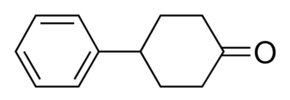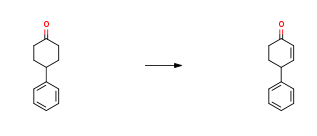4-Phenylcyclohexanone CAS#: 4894-75-1; ChemWhat Code: 459207
Identification
| Product Name | 4-Phenylcyclohexanone |
| IUPAC Name | 4-phenylcyclohexan-1-one |
| Molecular Structure |  |
| CAS Registry Number | 4894-75-1 |
| EINECS Number | 2045904 |
| MDL Number | MFCD00001641 |
| Beilstein Registry Number | 105692 |
| Synonyms | 1-phenyl-4-cyclohexanone, 4-(4-oxocyclohexyl)benzene, γ-phenylcyclohexanone, 4-(phenyl)cyclohexan-1-one, 4-phenyl-1-cyclo-hexanone, 4-phenyl-1-cyclohexanone, 4-phenylcyclohexan-1-one |
| Molecular Formula | C12H14O |
| Molecular Weight | 174.239 |
| InChI | InChI=1S/C12H14O/c13-12-8-6-11(7-9-12)10-4-2-1-3-5-10/h1-5,11H,6-9H2 |
| InChI Key | YKAYMASDSHFOGI-UHFFFAOYSA-N |
| Canonical SMILES | c1ccc(cc1)C2CCC(=O)CC2 |
| Patent Information | ||
| Patent ID | Title | Publication Date |
| JP2020/40928 | Novel cyclic diol compound (by machine translation) | 2020 |
| CN111517934 | Γ – alkenyl ketone and synthetic method thereof (by machine translation) | 2020 |
| JP2020/152715 | The compound, composition and a method for manufacturing a resist pattern (by machine translation) | 2020 |
| CN107739334 | Cu – MOF-type catalyst in the preparation of multi-substituted pyridine derivatives in the application of the (by machine translation) | 2018 |
Physical Data
| Appearance | White crystal |
| Solubility | slightly soluble |
| Refractive index | 1.5363 (estimate) |
| Melting Point, °C | Solvent (Melting Point) |
| 75 – 77 | |
| 78 – 79 | cyclohexane |
| 78.5 – 79.5 | petroleum ether |
| 76 – 77 | |
| 77.7 |
Spectra
| Description (NMR Spectroscopy) | Nucleus (NMR Spectroscopy) | Solvents (NMR Spectroscopy) | Frequency (NMR Spectroscopy), MHz |
| Chemical shifts | 1H | chloroform-d1 | 300 |
| Chemical shifts, Spectrum | 1H | chloroform-d1 | 600 |
| Chemical shifts, Spectrum | 13C | chloroform-d1 | 151 |
| Chemical shifts | 1H | chloroform-d1 | 500 |
| Spectrum | 13C | CDCl3 | 100 |
| Chemical shifts | 1H | CDCl3 | 400 |
| Chemical shifts | 13C | CDCl3 | 100 |
| NMR with shift reagents |
| Description (IR Spectroscopy) | Solvent (IR Spectroscopy) | Comment (IR Spectroscopy) |
| ATR (attenuated total reflectance), Bands | neat (no solvent, solid phase) | |
| Bands | potassium bromide | film |
| Bands | sodium chloride, chloroform | |
| Bands | KBr | ambient temperature |
| Spectrum | KBr | 2000 – 1000 cm**(-1) |
| Description (Mass Spectrometry) |
| APCI (atmospheric pressure chemical ionization), high resolution mass spectrometry (HRMS), spectrum |
| electron impact (EI), gas chromatography mass spectrometry (GCMS), spectrum |
| high resolution mass spectrometry (HRMS), spectrum |
| gas chromatography mass spectrometry (GCMS), electron impact (EI), spectrum |
| high resolution mass spectrometry (HRMS), time-of-flight mass spectra (TOFMS), spectrum |
| EI (Electron impact), Spectrum |
| spectrum, chemical ionization (CI) |
| Description (UV/VIS Spectroscopy) | Solvent (UV/VIS Spectroscopy) | Comment (UV/VIS Spectroscopy) |
| Absorption maxima | ||
| Spectrum | ethanol | 220 – 280 nm |
Route of Synthesis (ROS)
| Conditions | Yield |
| With 15-crown-5; N-tert-butyl benzenesulfinimidoyl chloride; lithium diisopropyl amide In tetrahydrofuran; hexane at -78℃; for 0.5h; | 84% |
| With palladium(II) trifluoroacetate; oxygen; acetic acid; dimethyl sulfoxide at 80℃; under 760.051 Torr; for 6h; | 83% |
| Stage #1: 1-phenyl-4-cyclohexanone With di-n-butylboryl trifluoromethanesulfonate; N-ethyl-N,N-diisopropylamine In fluorobenzene; dichloromethane Stage #2: With dichloro( 1,5-cyclooctadiene)platinum(ll); diallylcarbonate; silver trifluoroacetate In fluorobenzene; dichloromethane at 20℃; for 24h; Sealed tube; chemoselective reaction; | 60% |
Safety and Hazards
| Pictogram(s) |  |
| Signal | Warning |
| GHS Hazard Statements | H315 (100%): Causes skin irritation [Warning Skin corrosion/irritation] H319 (100%): Causes serious eye irritation [Warning Serious eye damage/eye irritation] H335 (100%): May cause respiratory irritation [Warning Specific target organ toxicity, single exposure; Respiratory tract irritation] Information may vary between notifications depending on impurities, additives, and other factors. |
| Precautionary Statement Codes | P261, P264, P271, P280, P302+P352, P304+P340, P305+P351+P338, P312, P321, P332+P313, P337+P313, P362, P403+P233, P405, and P501 (The corresponding statement to each P-code can be found at the GHS Classification page.) |
Other Data
| Transportation | NONH for all modes of transport |
| Under the room temperature and away from light | |
| HS Code | No data available |
| Storage | Under the room temperature and away from light |
| Shelf Life | 2 years |
| Market Price | USD |
| Use Pattern |
| 4-Phenylcyclohexanone CAS#: 4894-75-1 for treating cerebral vascular disorders such as cerebral ischemia, cardiac arrest, stroke and Parkinson’s disease |
| 4-Phenylcyclohexanone CAS#: 4894-75-1 Drug acting on the cardiovascular system |
Buy Reagent | |
| No reagent supplier? | Send quick inquiry to ChemWhat |
| Want to be listed here as a reagent supplier? (Paid service) | Click here to contact ChemWhat |
Approved Manufacturers | |
| Warshel Chemical Ltd | http://www.warshel.com/ |
| Want to be listed as an approved manufacturer (Requires approvement)? | Please download and fill out this form and send back to approved-manufacturers@chemwhat.com |
Other Suppliers | |
| Watson International Limited | Visit Watson Official Website |
Contact Us for Other Help | |
| Contact us for other information or services | Click here to contact ChemWhat |


